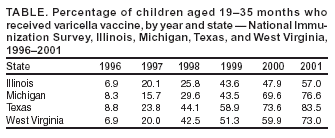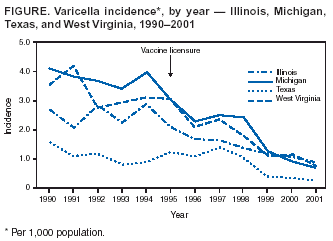 |
|
|
|
|
|
|
| ||||||||||
|
|
|
|
|
|
|
||||
| ||||||||||
|
|
|
|
|
Persons using assistive technology might not be able to fully access information in this file. For assistance, please send e-mail to: mmwrq@cdc.gov. Type 508 Accommodation and the title of the report in the subject line of e-mail. Decline in Annual Incidence of Varicella --- Selected States, 1990--2001Varicella (chickenpox) is a common, highly infectious, and vaccine-preventable disease. Before the introduction of the live attenuated varicella vaccine in 1995, approximately 4 million cases of varicella occurred annually in the United States, resulting in approximately 11,000 hospitalizations and 100 deaths (1--3). In 1996, the Advisory Committee on Immunization Practices (ACIP) recommended routine vaccination of all children at age 12--18 months, catch-up vaccination of all susceptible children before age 13 years, and vaccination of susceptible persons with close contact to persons at high risk for serious complications (4). In 1999, ACIP updated these recommendations to include vaccination requirements for child care and school entry and for postexposure; ACIP also strengthened recommendations for vaccination of susceptible adults and indicated that varicella vaccine should be considered for outbreak control (5). Changes in the national annual reported incidence of varicella disease during 1972--1997 have been reported previously (6). This report summarizes trends in the annual reported incidence of varicella disease in selected states during 1990--2001. The findings underscore the continued need to improve varicella surveillance to monitor the impact of the varicella vaccination program and assess any changes in varicella transmission and disease. CDC reviewed all varicella cases in states with adequate and consistent reporting to the National Notifiable Disease Surveillance System (NNDSS) during 1990--2001; reporting was considered adequate if states reported cases equivalent to >5% of their birth cohort before 1995 and consistent if their reporting methods did not change throughout the study period. Annual state population estimates were obtained from the U.S. Census Bureau, and vaccination coverage rates were obtained from the National Immunization Survey (7). State-specific annual incidence was calculated by using all cases reported for each year divided by the state's total population. During 1990--2001, four states (Illinois, Michigan, Texas, and West Virginia) had adequate and consistent reporting levels. Reporting levels ranged from 6% in Texas to 25% in Michigan. During 1990--1994, the average reported incidence of varicella in all four states remained stable, ranging from 1.1 cases per 1,000 population in Texas to 3.8 in Michigan (Figure). Starting in 1999, varicella incidence declined steadily, with the average for 1999--2001 ranging from 0.3 in Texas to 1.0 in Illinois. For all four states, the lowest reported incidence occurred in 2001, ranging from 0.3 in Texas to 0.9 in Illinois. Compared with the average incidence for 1990--1994, reduction in varicella disease in 2001 ranged from 67% in Illinois to 82% in Michigan. This decrease in incidence corresponded with the steady increase in vaccination coverage (Table). In 2001, vaccination coverage for children aged 19--35 months reached 57% in Illinois, 73% in West Virginia, 77% in Michigan, and 84% in Texas. States with higher vaccination coverage (Michigan, Texas, and West Virginia) implemented child care and/or school entry requirements in 2000, and Illinois implemented such requirements in 2002. Reported by: A Ali, MD, D Path, MPH, Immunization Svcs Div; H Nguyen, MPH, A Jumaan, PhD, J Zhang, PhD, P Spradling, MD, J Seward, MBBS, Epidemiology and Surveillance Div, National Immunization Program, CDC. Editorial Note:The findings in this report suggest that the steady decline in reported varicella incidence during 1999--2001 resulted from the increased use of varicella vaccine and not a decrease in reporting. These findings are consistent with data from three active surveillance sites at which individual cases are investigated (Antelope Valley, California; West Philadelphia, Pennsylvania; and Travis County, Texas). During 1995--2000, incidence of varicella for all age groups in these three sites declined substantially (range: 76%--87%), corresponding with the high average vaccination coverage of 80% (8). The availability of a safe and effective varicella vaccine has reduced the impact of the disease substantially. High vaccination coverage levels among all age groups are necessary to ensure that persons do not reach adolescence or adulthood without having immunity to varicella. At the start of the 2002 school year, 33 states had implemented child care or school entry requirements for varicella (CDC, unpublished data, 2003), and five more states implemented such requirements in September 2003. The existing national varicella surveillance system is not adequate to monitor the incidence of varicella disease or to assess the impact of the vaccination program. In 2001, disease incidence was reported by 22 states and the District of Columbia; however, only four states had adequate and consistent reporting for the study period. The Council of State and Territorial Epidemiologists has recommended that by 2005, states establish or enhance varicella surveillance programs that provide individual case reporting (9). To enhance their surveillance programs, states should collect key variables, including vaccination history, age at disease onset, and severity of disease. Collecting these data will enable states to detect changes in varicella epidemiology, which will be valuable in targeting vaccination programs, assessing the need for a change in vaccine policy, and further reducing the varicella disease burden. In addition, as circulation of the varicella-zoster virus decreases with the decline in incidence, laboratory confirmation of disease will become more important. CDC and the Association of Public Health Laboratories have upgraded the diagnostic capability of national and state laboratories to support varicella disease diagnosis and enhance national and state surveillance. Acknowledgments This report is based on data contributed by M Dworkin, MD, Illinois Dept of Public Health. M Boulton, MD, Michigan Dept of Health. D Perrotta, PhD, Texas Dept of Health. L Haddy, MS, West Virginia Dept of Health and Human Resources. References
Table  Return to top. Figure  Return to top.
Disclaimer All MMWR HTML versions of articles are electronic conversions from ASCII text into HTML. This conversion may have resulted in character translation or format errors in the HTML version. Users should not rely on this HTML document, but are referred to the electronic PDF version and/or the original MMWR paper copy for the official text, figures, and tables. An original paper copy of this issue can be obtained from the Superintendent of Documents, U.S. Government Printing Office (GPO), Washington, DC 20402-9371; telephone: (202) 512-1800. Contact GPO for current prices. **Questions or messages regarding errors in formatting should be addressed to mmwrq@cdc.gov.Page converted: 9/18/2003 |
|||||||||
This page last reviewed 9/18/2003
|